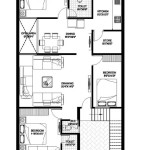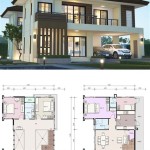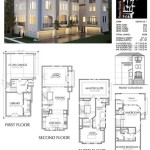Rear Sloping Lot House Plans refer to architectural designs specifically tailored for building houses on properties where the backyard slopes downward from the house. These plans account for the unique challenges and opportunities presented by such terrains. One common application is in hilly or mountainous areas, where houses are often built on lots with significant elevation changes.
Designing houses on rear sloping lots requires careful planning to ensure proper drainage, foundation stability, and optimal use of the available space. Rear Sloping Lot House Plans offer innovative solutions to these challenges, such as incorporating split-level designs, walkout basements, and terraced landscaping. By considering the natural contours of the land, these plans create homes that blend seamlessly with their surroundings while maximizing functionality and aesthetic appeal.
In the following sections, we will delve deeper into the key considerations, advantages, and design strategies involved in Rear Sloping Lot House Plans. This guide will provide valuable insights for homeowners, architects, and builders navigating the unique challenges and opportunities of building on rear sloping lots.
Here are 8 important points about Rear Sloping Lot House Plans:
- Consider drainage and erosion control.
- Plan for split-level designs or walkout basements.
- Maximize natural light with large windows.
- Incorporate terraced landscaping for visual interest.
- Utilize retaining walls for slope stabilization.
- Design outdoor living spaces that blend with the terrain.
- Consider the impact of slope on access and parking.
- Consult with experienced architects and engineers.
By carefully considering these points, you can create a beautiful and functional home on a rear sloping lot.
Consider drainage and erosion control.
Drainage is critical on a sloping lot. Water can quickly erode the soil and damage your foundation. To prevent this, you need to have a plan for managing stormwater runoff.
- Install gutters and downspouts. Gutters and downspouts will help to collect and direct rainwater away from your house. Make sure that the downspouts are extended away from the foundation so that the water doesn’t pool around your house.
- Grade the land around your house. The land around your house should be graded so that water flows away from the foundation. This will help to prevent water from seeping into your basement or crawlspace.
- Plant vegetation. Vegetation can help to hold the soil in place and prevent erosion. Plant trees and shrubs around your house, and consider using groundcovers on slopes.
- Install erosion control measures. If you have a steep slope, you may need to install erosion control measures such as retaining walls or gabions. These measures will help to prevent the soil from eroding and damaging your property.
By taking these steps, you can help to ensure that your home is protected from water damage and erosion.
Plan for split-level designs or walkout basements.
On a rear sloping lot, you may want to consider a split-level design or a walkout basement. These designs can take advantage of the natural slope of the land and create additional living space.
- Split-level designs
Split-level homes are characterized by different levels that are connected by stairs. This design can work well on sloping lots because it allows you to create different living spaces on different levels. For example, you could have the kitchen and living room on the main level, the bedrooms on the upper level, and the family room on the lower level. - Walkout basements
Walkout basements are basements that have a door that leads directly to the backyard. This type of basement can be a great way to add additional living space to your home. You could use the walkout basement for a family room, a playroom, or even a guest suite.
Both split-level designs and walkout basements can be a great way to take advantage of a sloping lot. They can create additional living space, and they can also help to make your home more energy-efficient.
Maximize natural light with large windows.
One of the best ways to take advantage of a rear sloping lot is to maximize natural light with large windows. Natural light can make your home feel more spacious and inviting, and it can also help to reduce your energy costs.
- Place windows on the south side of your home. The south side of your home receives the most sunlight, so this is the best place to put your windows. Large windows on the south side of your home will let in plenty of natural light and help to keep your home warm in the winter.
- Use skylights to bring in light from above. Skylights are a great way to bring in natural light from above. They can be installed in any room of your home, and they can make a big difference in the amount of natural light that you have.
- Choose windows with large panes of glass. Windows with large panes of glass will let in more natural light than windows with small panes of glass. When choosing windows, look for windows with large panes of glass and narrow frames.
- Avoid placing furniture or other objects in front of windows. If you place furniture or other objects in front of windows, you will block the natural light from coming into your home. Make sure that your windows are clear of obstructions so that you can enjoy the benefits of natural light.
By following these tips, you can maximize natural light in your rear sloping lot home. Natural light can make your home feel more spacious and inviting, and it can also help to reduce your energy costs.
Incorporate terraced landscaping for visual interest.
Terraced landscaping is a great way to add visual interest to a rear sloping lot. Terraces are flat areas of land that are created by cutting into the slope of the land. They can be used to create different levels of outdoor living space, and they can also be used to grow plants and flowers.
There are many different ways to incorporate terraced landscaping into a rear sloping lot home. One popular option is to create a series of terraces that lead down the slope of the land. This can create a dramatic visual effect, and it can also provide a great place to relax and enjoy the outdoors.
Another option is to create a terrace that is surrounded by a retaining wall. This type of terrace can be used to create a more private outdoor space, and it can also be used to protect plants from the elements.
Terraced landscaping can be a great way to add beauty and functionality to a rear sloping lot home. By incorporating terraced landscaping into your design, you can create a unique and inviting outdoor space that you can enjoy for years to come.
Utilize retaining walls for slope stabilization.
Retaining walls are an important part of many rear sloping lot house plans. They are used to stabilize slopes and prevent erosion. Retaining walls can be made from a variety of materials, including concrete, stone, and wood. The type of material used will depend on the size and slope of the retaining wall, as well as the overall design of the house.
Retaining walls work by holding back the soil on a slope. They do this by creating a barrier that prevents the soil from moving downhill. Retaining walls can also be used to create level areas on a slope, which can be used for patios, decks, or other outdoor living spaces.
When designing a retaining wall, it is important to consider the following factors:
- The height of the wall. The height of the wall will determine how much soil it can hold back. A taller wall will be able to hold back more soil than a shorter wall.
- The slope of the land. The slope of the land will also affect the design of the retaining wall. A steeper slope will require a stronger wall than a gentler slope.
- The type of soil. The type of soil on the slope will also affect the design of the retaining wall. Sandy soil will require a different type of wall than clay soil.
- The overall design of the house. The retaining wall should be designed to complement the overall design of the house. It should be made from materials that match the house and it should be built in a style that is consistent with the house.
Retaining walls can be a valuable addition to any rear sloping lot home. They can help to stabilize slopes, prevent erosion, and create level areas for outdoor living. When designing a retaining wall, it is important to consider the factors discussed above to ensure that the wall is safe and functional.
Design outdoor living spaces that blend with the terrain.
When designing outdoor living spaces on a rear sloping lot, it is important to consider the natural contours of the land and to design spaces that blend seamlessly with the terrain. This can be achieved by using materials that are sympathetic to the natural surroundings, such as stone, wood, and plants. It is also important to create spaces that are both functional and visually appealing.
One way to create a cohesive outdoor living space on a rear sloping lot is to use terraced landscaping. Terraces are flat areas of land that are created by cutting into the slope of the land. They can be used to create different levels of outdoor living space, and they can also be used to grow plants and flowers. Terraces can be connected by stairs or ramps, and they can be used to create a variety of different outdoor spaces, such as patios, decks, and gardens.
Another way to create a cohesive outdoor living space on a rear sloping lot is to use retaining walls. Retaining walls are walls that are built to hold back soil on a slope. They can be made from a variety of materials, such as concrete, stone, and wood. Retaining walls can be used to create level areas on a slope, which can be used for patios, decks, or other outdoor living spaces. Retaining walls can also be used to create visual interest and to add privacy to an outdoor space.
When designing outdoor living spaces on a rear sloping lot, it is important to consider the following factors:
- The slope of the land. The slope of the land will affect the design of the outdoor living spaces. A steeper slope will require more terracing and retaining walls than a gentler slope.
- The type of soil. The type of soil on the slope will also affect the design of the outdoor living spaces. Sandy soil will require different types of retaining walls and landscaping than clay soil.
- The amount of sunlight. The amount of sunlight that the slope receives will also affect the design of the outdoor living spaces. A slope that receives a lot of sunlight can be used for growing plants and flowers, while a slope that receives less sunlight may be better suited for a patio or deck.
- The overall design of the house. The outdoor living spaces should be designed to complement the overall design of the house. They should be made from materials that match the house and they should be built in a style that is consistent with the house.
By considering these factors, you can create outdoor living spaces that blend seamlessly with the terrain and that are both functional and visually appealing.
Consider the impact of slope on access and parking.
The slope of your lot will also impact access and parking. If your lot is on a steep slope, you may need to build a driveway that is longer and more winding than a driveway on a flat lot. You may also need to build a retaining wall to support the driveway and prevent erosion.
In addition, you will need to consider the impact of the slope on parking. If your lot is on a steep slope, you may not be able to park your car in a garage. Instead, you may need to park your car in a carport or on a driveway.
Here are some specific points to consider when planning for access and parking on a rear sloping lot:
- The grade of the driveway. The grade of the driveway is the slope of the driveway. A steeper driveway will be more difficult to drive on, especially in icy or snowy conditions. If your lot is on a steep slope, you may need to build a driveway with a switchback or a series of terraces to reduce the grade.
- The length of the driveway. The length of the driveway will depend on the size of your lot and the location of your house. A longer driveway will be more expensive to build and maintain. If your lot is on a steep slope, you may need to build a longer driveway to reach your house.
- The width of the driveway. The width of the driveway will depend on the size of your vehicles and the amount of traffic that you expect. A wider driveway will be easier to drive on and will allow you to park more cars. If your lot is on a steep slope, you may need to build a wider driveway to accommodate the turning radius of your vehicles.
- The type of driveway surface. The type of driveway surface will depend on your budget and your needs. Asphalt and concrete are the most common driveway surfaces, but they can be expensive to install. Gravel and dirt are less expensive options, but they can be more difficult to maintain.
By considering these factors, you can plan for access and parking on your rear sloping lot that is safe and convenient.
Consult with experienced architects and engineers.
When designing and building a house on a rear sloping lot, it is important to consult with experienced architects and engineers. These professionals can help you to design a home that is safe, functional, and beautiful.
Architects can help you to create a design that takes into account the unique challenges and opportunities of rear sloping lots. They can also help you to select the right materials and construction methods for your home.
Engineers can help you to ensure that your home is structurally sound and that it can withstand the forces of gravity, wind, and snow. They can also help you to design a drainage system that will prevent water from damaging your home.
Here are some specific benefits of consulting with experienced architects and engineers when building a house on a rear sloping lot:
- They can help you to design a home that is safe and functional. Architects and engineers can help you to design a home that meets all of your needs and that is safe for your family to live in. They can also help you to design a home that is energy-efficient and that has a low environmental impact.
- They can help you to select the right materials and construction methods for your home. Architects and engineers can help you to select the right materials and construction methods for your home based on your budget and your needs. They can also help you to find ways to save money on the construction of your home.
- They can help you to design a drainage system that will prevent water from damaging your home. Architects and engineers can help you to design a drainage system that will prevent water from damaging your home. They can also help you to choose the right plants and landscaping to help prevent erosion.
By consulting with experienced architects and engineers, you can help to ensure that your rear sloping lot home is safe, functional, and beautiful.
In addition to the benefits listed above, consulting with experienced architects and engineers can also help you to avoid costly mistakes. Architects and engineers can help you to identify potential problems with your design and to develop solutions before construction begins. This can help you to save money and time in the long run.
If you are planning to build a house on a rear sloping lot, it is important to consult with experienced architects and engineers. These professionals can help you to design and build a home that is safe, functional, and beautiful.










Related Posts








